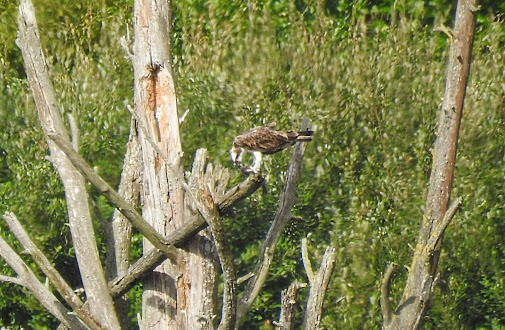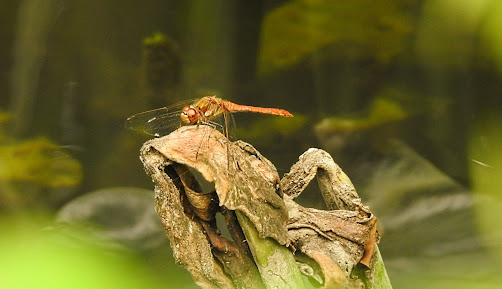Saturday 29 July 2023.
It was a wet drive up to Andy’s house this morning which resulted in a good thing and a bad thing. Before driving up the A3, I popped to the petrol station first of all and while filling up, a female Peregrine was seen with prey in its talons, heading south over Fratton Park. A good start to the day. However, on my way up the A3, with rain coming down, I saw a Blackbird try to cross the dual carriageway, but was hit by the car in front of me. To see its poor wing flapping loosely in the road was not what I wanted to see first thing in the morning.
Andy had his moth box on again last night, though I didn’t. I don’t normally trap two nights running and so kept mine off overnight. Fortunately for me, Andy had a very good selection that included three more new for the year: July Highflyer, Scalloped Oak and Rosy Footman. There were 45 moths of 27 species recorded this morning and as well as the above mentioned, there were also some nice moths along with it including 2 Maidens Blush, Garden Pebble, Blair’s Mocha, Tree-lichen Beauty and a three species of Grass-veneer.
Moths present in and around Andy’s moth box included the following:
- 2 Riband Wave
- 1 Rosy Footman (NFY)
- 3 Willow Beauty
- 1 July Highflyer (NFY)
- 3 Uncertain
- 1 Double-striped Pug
- 3 Scalloped Oak (NFY)
- 1 Single-dotted Wave
- 2 Maiden’s Blush
- 1 Blair’s Mocha
- 1 Tree-lichen Beauty
- 1 Common Pug
- 1 Common Rustic
- 2 Shuttle-shaped Dart
- 1 Silver Y
- 1 Garden Pebble
- 2 Bird-cherry Ermine
- 1 Bud Moth
- 1 Codling Moth
- 2 Common Plume
- 1 Marbled Piercer
- 5 Rosy Tabby
- 1 Light Brown Apple Moth
- 2 Common Grass-veneer
- 3 Inlaid Grass-veneer
- 2 Garden Grass-veneer
- 1 Small Grey
Our destination today was going to be Fishlake Meadows, Romsey, where, after picking up birding pal, Geoff Farwell, we done the 30 miles in a reasonable time (though Andy had to get some food from a nearby shop first!) and once in the car park, we made our way northbound along the Canal Path. Some of the ‘Lazee Birders’ had already reported that they had seen an Osprey over the reserve on the Whatsapp site and it didn't take long to see my first one of the year, perched up in one of the dead trees, eating a fish!
I knew it was going to be a showery day today, but apart from the occasional shower, it was mostly dry and sunny and quite warm; excellent conditions for both Butterflies and Dragonflies. This is only the second time both Andy and myself had been to this reserve, but it was a first for Geoff and he told me later that he was really impressed with the place. I shall kick off with the bird sightings first of all and of course, the Osprey took the honours. Geoff picked the bird up first of all, perched on top of one of the dead trees, tucking into his breakfast. I quickly put a fellow birder onto the bird as all four of us enjoyed prolonged views of the raptor.
It wasn't a bad day for raptors and along with the Peregrine and Osprey, we had sightings of a couple of Red Kites, a Common Buzzard and a female Sparrowhawk. Sadly, no Hobbies were seen today, despite ideal conditions. Water Rails were heard several times calling in the reedbeds and though we were so close in seeing our second ‘year-tick’ of the day, there were no sightings at all of this elusive species. I think we have a better chance when Autumn arrives when they are much more showy.
While watching the Osprey, there were at least two Great White Egrets near the bird; one perched on one of the dead trees and another wading on the marsh below. Later in the day, up to four birds were seen on the reserve from one of the viewpoints looking west. A few Grey Herons and several Cormorants were also perched on the dead trees. Overhead, there was a good number of Hirundines hawking for insects that included mostly House Martins. There were sightings of a few Swallows, Sand Martins and the occasional Swift too. A family flock of Nuthatches flew past us in the trees by the Canal Path and warblers present seen today on the reserve included Reed and Sedge Warblers, Cetti’s Warblers, Chiffchaffs and a female Blackcap.
From the Viewing Screen (which was the first time we had been here due to the footpath being flooded earlier in the year), we encountered at least 6 Common Terns flying around the lake. We believe one was probably a male bird which was carrying a fish, courting a female bird and excitedly calling to her. Could they be late breeders? A Kingfisher flashed past twice over the lake and at least a dozen Gadwall were on the water swimming near the reeds and occasionally taking flight. One of the Water Rails was literally around 10 feet away from us ‘squealing’ loudly deep within the reedbeds. How frustrating was that!
There was a good haul of butterflies around the reserve that included up to 10+ Brimstones in just one particular area, nectaring on Greater Burdock. Geoff, who is a very good botanist, told me that these plants are not very common and was pleased that so many were on the reserve. Other butterflies included Peacock, Large & Small White, Holly Blue, Red Admiral, Speckled Wood and Comma. Regarding Dragonflies and Damselflies, there were sightings of Southern Hawkers, a male Black-tailed Skimmer, a male Common Darter, a female Demoiselle Damselfly, Blue-tailed Damselfly and several Blue species of Damselfly. A lot of these insects were seen along the River Test that borders the western side of the reserve. The slow, chalk stream water attracted a lot of fish that included some very large Perch, probably Gudgeon and a lot of smaller fish.
Geoff posed the question to one of the reserve wardens about why the Willow Tree leaves were all brown and it turned out that there was a Beetle, a Willow Leaf Beetle was the actual cause of this. On closer inspection, Geoff picked one of the infected leaves and sure enough, out popped one of the Beetles! Apparently, the Willow Tree does recover from the infection after a while. Interesting stuff!
Along the footpaths, Geoff was pointing out to both of us the fascinating plants along the way that included Water Speedwell, Water Forget-me-not, Greater Plantain, Enchanters Nightshade, Fools Watercress (which is a very poisonous plant!), the colourful pink Amphibious Bistort and the attractive Arrowhead plants. The likes of Ragwort, Spear Thistle, Purple Loosestrife and Great Willowherb, all of which dominated the footpaths.
We spent a good seven hours on the reserve, which was well spent on this excellent area. We will most certainly return again, most likely in the Autumn where there could be a wealth of migrant birds arriving here. Judging by the recent sightings board, there were some decent sightings including a Bittern heard here.











.JPG)




.JPG)





.JPG)




.JPG)




No comments:
Post a Comment